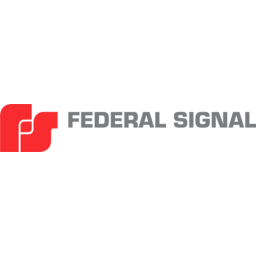
P/E ratio for Federal Signal (FSS)
P/E ratio as of April 2024 (TTM): 37.7
According to Federal Signal's latest financial reports and stock price the company's current price-to-earnings ratio (TTM) is 37.6652. At the end of 2022 the company had a P/E ratio of 23.4.
P/E ratio history for Federal Signal from 2001 to 2023
PE ratio at the end of each year
| Year | P/E ratio | Change |
|---|---|---|
| 2022 | 23.4 | -10.56% |
| 2021 | 26.1 | 25.94% |
| 2020 | 20.7 | 15.71% |
| 2019 | 17.9 | 41.35% |
| 2018 | 12.7 | -35.02% |
| 2017 | 19.5 | -10.04% |
| 2016 | 21.7 | 39.52% |
| 2015 | 15.5 | 1.65% |
| 2014 | 15.3 | 167.13% |
| 2013 | 5.72 | -133.84% |
| 2012 | -16.9 | -10.35% |
| 2011 | -18.9 | 741.44% |
| 2010 | -2.24 | -117.5% |
| 2009 | 12.8 | -408.9% |
| 2008 | -4.15 | -142.13% |
| 2007 | 9.84 | -71.16% |
| 2006 | 34.1 | -122.74% |
| 2005 | -150 | -66% |
| 2004 | -442 | -2090.78% |
| 2003 | 22.2 | -7.33% |
| 2002 | 23.9 | 5.31% |
| 2001 | 22.7 |
P/E ratio for similar companies or competitors
| Company | P/E ratio | P/E ratio differencediff. | Country |
|---|---|---|---|
 Cintas CTAS | 49.4 | 31.15% | 🇺🇸 USA |
 Kandi Technologies Group KNDI | -51.0 | -235.48% | 🇨🇳 China |
 Gentex GNTX | 20.2 | -46.47% | 🇺🇸 USA |
 Tata Motors TATAMOTORS.NS | 496 | 1,215.90% | 🇮🇳 India |
How to read a P/E ratio?
The Price/Earnings ratio measures the relationship between a company's stock price and its earnings per share. A low but positive P/E ratio stands for a company that is generating high earnings compared to its current valuation and might be undervalued. A company with a high negative (near 0) P/E ratio stands for a company that is generating heavy losses compared to its current valuation.
Companies with a P/E ratio over 30 or a negative one are generaly seen as "growth stocks" meaning that investors typically expect the company to grow or to become profitable in the future.
Companies with a positive P/E ratio bellow 10 are generally seen as "value stocks" meaning that the company is already very profitable and unlikely to strong growth in the future.